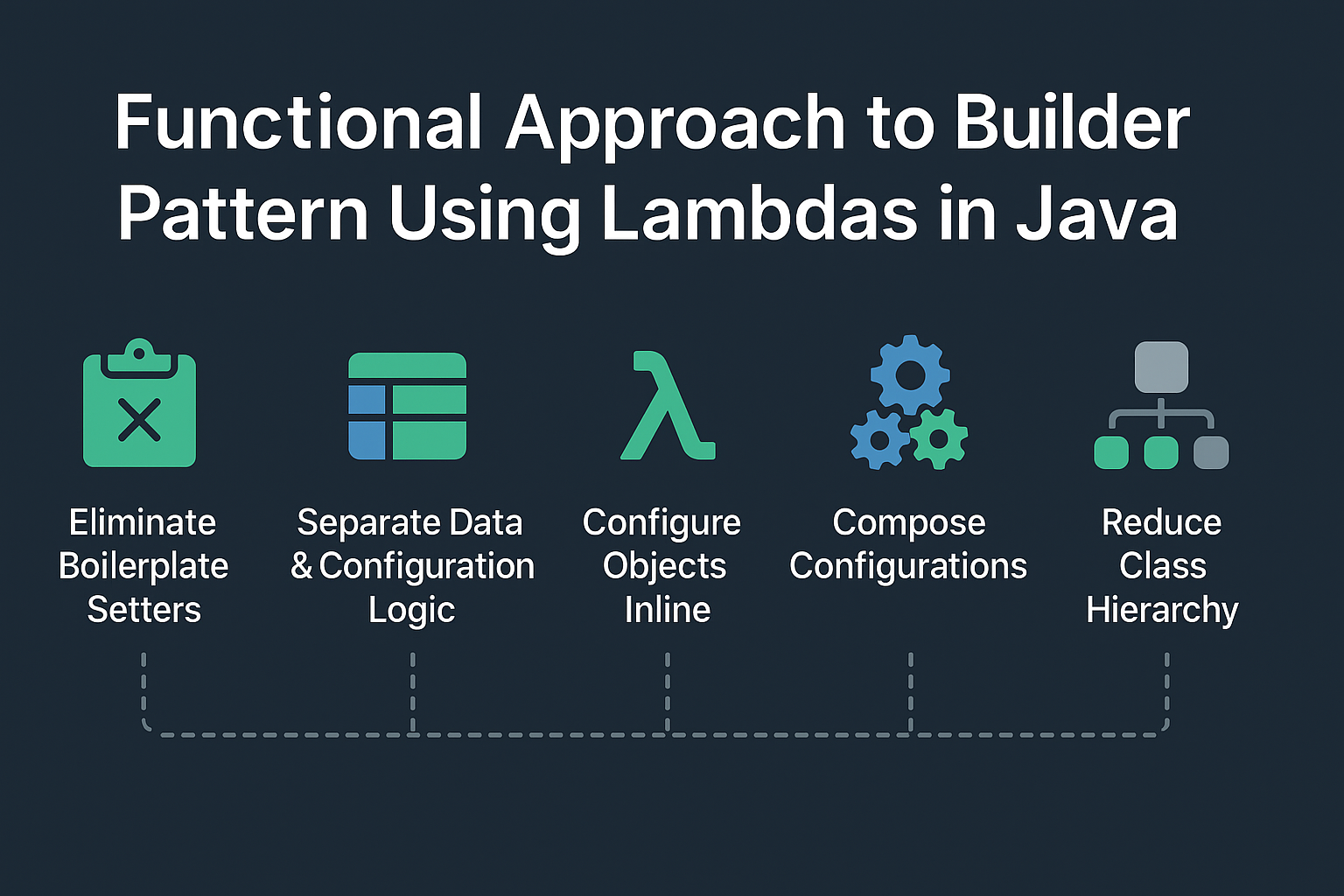The Builder Pattern is a popular design pattern in Java that simplifies object construction by chaining method calls. But with the advent of lambdas and functional interfaces in Java 8, we can go even further: transforming the Builder Pattern into a functional, elegant, and highly readable style.
This tutorial explores a modern way to implement the Builder Pattern using lambdas, Consumer, and method chaining to produce clean and maintainable Java code.
🧱 Traditional Builder Pattern
public class Person {
private String name;
private int age;
public static class Builder {
private String name;
private int age;
public Builder setName(String name) {
this.name = name;
return this;
}
public Builder setAge(int age) {
this.age = age;
return this;
}
public Person build() {
return new Person(name, age);
}
}
public Person(String name, int age) {
this.name = name;
this.age = age;
}
}
Usage
Person person = new Person.Builder()
.setName("Ash")
.setAge(30)
.build();
✅ Builder Pattern with Lambdas
We can use a functional style using Consumer<T> to eliminate boilerplate setters:
public class Person {
private String name;
private int age;
public static Person build(Consumer<Person> builder) {
Person person = new Person();
builder.accept(person);
return person;
}
// Setters required for Consumer access
public void setName(String name) { this.name = name; }
public void setAge(int age) { this.age = age; }
@Override
public String toString() {
return name + ", " + age;
}
}
Usage
Person p = Person.build(person -> {
person.setName("Ashwani");
person.setAge(32);
});
✅ Benefits:
- Clear separation of data and configuration logic
- Inline and readable object configuration
- Reduces boilerplate class hierarchy
🔁 Composable Functional Builders
You can reuse and compose configurations:
Consumer<Person> setName = p -> p.setName("John");
Consumer<Person> setAge = p -> p.setAge(40);
Consumer<Person> config = setName.andThen(setAge);
Person p = Person.build(config);
🔧 Generic Functional Builder Template
public class Builder<T> {
private final Supplier<T> instantiator;
private final List<Consumer<T>> modifiers = new ArrayList<>();
public Builder(Supplier<T> instantiator) {
this.instantiator = instantiator;
}
public Builder<T> with(Consumer<T> modifier) {
modifiers.add(modifier);
return this;
}
public T build() {
T value = instantiator.get();
modifiers.forEach(mod -> mod.accept(value));
return value;
}
}
Usage
Builder<Person> builder = new Builder<>(Person::new);
Person p = builder
.with(p1 -> p1.setName("Alice"))
.with(p1 -> p1.setAge(28))
.build();
🔄 Functional vs Traditional Builder
| Feature | Traditional Builder | Functional Builder (Lambdas) |
|---|---|---|
| Boilerplate | High | Low |
| Readability | Decent | Very high |
| Flexibility | Medium | High |
| Inheritance support | Good | Requires care |
| Immutability | Can support | With tricks (e.g., records) |
📚 Real-World Use Case: Request Builder
public class Request {
private String endpoint;
private Map<String, String> headers = new HashMap<>();
public static Request build(Consumer<Request> config) {
Request r = new Request();
config.accept(r);
return r;
}
public void setEndpoint(String endpoint) {
this.endpoint = endpoint;
}
public void addHeader(String k, String v) {
headers.put(k, v);
}
public void send() {
System.out.println("Sending to: " + endpoint);
System.out.println("Headers: " + headers);
}
}
Usage
Request req = Request.build(r -> {
r.setEndpoint("/api/data");
r.addHeader("Auth", "token-123");
});
req.send();
📌 What's New in Java?
Java 8
- Lambdas,
Consumer,Supplier, method references
Java 9
Optional.ifPresentOrElse, more collector patterns
Java 11
varin lambda parameters
Java 17
- Records simplify immutable builders
Java 21
- Structured concurrency and scoped values allow safer builder usage in threads
✅ Conclusion and Key Takeaways
- The Builder Pattern simplifies object creation, and lambdas make it even more elegant.
- Use
Consumer<T>to apply configurations inline without setters or nested classes. - Composable lambdas reduce redundancy and promote reusable configurations.
- Functional builders are ideal for test data setup, configuration objects, and flexible DSLs.
❓ Expert FAQ
Q1: Is the functional builder pattern thread-safe?
Only if the object and lambdas are stateless or synchronized.
Q2: Can I use method references instead of lambdas?
Yes, if the method matches the Consumer or Function signature.
Q3: Can functional builders support validation?
Yes—validate in the build() method or via custom with() logic.
Q4: Are functional builders more memory efficient?
Slightly—fewer classes, no inner builder objects.
Q5: Should I use this in production code?
Yes, especially for config-heavy or test-heavy code.
Q6: What about immutable builders?
Use record types or return new objects in with() instead of modifying fields.
Q7: Are there downsides?
You lose compile-time checks of traditional fluent APIs unless you’re careful.
Q8: Can this approach be used in Spring or Jakarta EE?
Yes, especially for configuration objects, beans, or startup pipelines.
Q9: How is this different from JavaScript builders?
Java requires strong typing and controlled lambdas, unlike JavaScript’s dynamic object mutation.
Q10: Is this approach compatible with Lombok?
Yes, but Lombok already offers @Builder, which is a different pattern. You can combine them.
